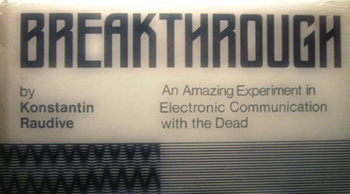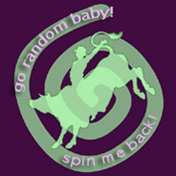Fri 30 Sep 2005
Incantation (Part 3)
Posted by anaglyph under Books, Ephemera, Geek, Music, Spooky
[13] Comments

Try this (you will need about ten uninterrupted minutes):
Tune your tv to a channel that is just static. Make sure it’s not close to any actual transmission – it should be pure static. Turn the volume up to a comfortable level, not too loud. Sit close enough to the screen that it fills up most of your view. Now just watch attentively. In a few minutes you will start to see things. Shapes, movements at first, but then, possibly, faces, figures, objects. Soon enough you will hear voices in the static, and perhaps even music.
Go outside and look at the clouds. It doesn’t take long to find a face or an animal.
Hardly a week goes by these days without a tv report about someone finding a figure of The Virgin Mary in a cheese sandwich or an image of Mother Theresa in a cinnamon bun.
It’s plain to me what’s going on here – we see or hear a fuzzy enough data cloud and our brains leap in and impose some order on it. I imagine that once long ago when we were all living in the long grasses on the veldt, this capability came in mighty useful in picking out the shape of a hungry predator camouflaged in the shadows.
The whole thing comes unstuck though when there is actually nothing in the data but noise. Given a sufficient motivation, we can find pretty much anything we want in that chaos.
If it’s a case of lying on the grass looking at the clouds and playing ‘Find Elvis’ we pretty much understand it for what it is. Occasionally though, some suggestible people start to believe that it can’t just be randomness and that there is a message there, typically from God or the spirit world, trying to get through to us.
It’s instructive to listen to some EVP recordings without reading what the ‘voices’ are meant to be saying. The CD I mentioned in the last post The Ghost Orchid has a large selection of recordings of alleged spirit communications. The first time I listened to it, I couldn’t hear any sensible words at all in the faint voice-like sounds. Sure, they sound like voices (mostly…), but to my ear, just static-affected grabs of partially tuned radio signals. I could make a stab at what they might be saying, but I wouldn’t wager my house on any of it. Reading the transcriptions, though, like reading the transcriptions in Breakthrough is very instructive. It is clear that most of the content in these messages is coming from the mind of the interpreter rather than anything the voices are ‘saying’. In some cases, what I am being told the voices are saying does not in any way sound to me like what I am hearing.
I like ghost stories, but I don’t believe in ghosts. I think that the fact that large numbers of people are convinced they have been abducted by aliens is fascinating, even though I don’t believe for a moment they have. I find the fin de siecle obsession with Spiritualism endlessly intriguing but I don’t think there is a life after death. I thought the whole ‘Crop Circle’ phenomenon was wonderful, but I didn’t for an instant think that the circles were being made by extraterrestrials. What interests me is not so much these phenomena per se, but the people involved with them.
Human beings are amazing in the breadth of their capacity to be fooled. More than that, we want to be fooled, which is why it is so easy. Ask any magician.





